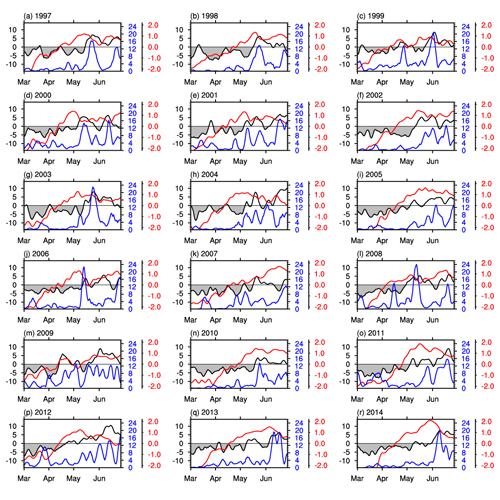
The South China Sea summer monsoon (SCSSM) greatly influences the socioeconomics of the regions it affects. Its onset mechanism is therefore a popular topic among atmospheric science researchers. However, due to the complexity of the interactions among land, ocean, atmosphere and topography, the definition of the SCSSM onset date is quite controversial and remains uncertain.
In a paper published in Atmospheric and Oceanic Science Letters in October 2016, Dr. HE Bian from Institute of Atmospheric Physics, Chinese Academy of Sciences and his colleagues studied the SCSSM onset during 1997 to 2014.They proposed four indices that depict the SCSSM onset from both the dynamical and thermal perspectives. Three distinct onset types were identified: among the 18 years studied, nine were normal onset years, characterized by a well-established westerly wind and associated precipitation over the South China Sea (SCS); eight were intermittent onset years, in which monsoon precipitation does not occur continuously following the establishment of the westerly wind over the SCS; and one year, 2014, was a delayed onset year, in which the western Pacific subtropical high dominated over the SCS after the seasonal transition and prevented the monsoon onset.

Time series of 850 hPa zonal wind (black; units: m s−1), precipitation (blue; mm d−1), and SST (red; units: K), averaged over (5–20°N, 110–120°E), for (a–r) 1997 to 2014. Gray shaded areas denote periods of easterly wind. (He et al., 2016)
A comparison of the first two types suggested that a positive SST gradient in the northern Indian Ocean and local SST warming in the SCS are two key factors in the normal SCSSM onset type. With regard to the influence of the El Niño–Southern Oscillation background, there were four late onset years (1997, 1998, 2007 and 2010) that coincided with El Niño events, but only two early-onset years (1999 and 2012) out of the six years featuring La Niña events.
“Our further analysis suggested that the zonal thermal contrast across the Indian and western Pacific oceans modulates monsoon onset in La Niña years.” Dr. HE concluded.

86-10-68597521 (day)
86-10-68597289 (night)

86-10-68511095 (day)
86-10-68512458 (night)

cas_en@cas.cn

52 Sanlihe Rd., Xicheng District,
Beijing, China (100864)

